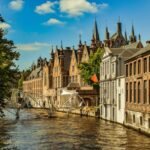Introduction to St. Petersburg
Founded in 1703 on the marshlands at the deepest point of the Gulf of Finland, this city has undergone multiple name changes over the past 300 years—Leningrad, Petrograd, and St. Petersburg. Its history has been filled with ups and downs, from surviving the horrors of the White Terror to standing strong during the 900-day siege, and witnessing the Great Patriotic War. Despite the bombings and bloodshed, its brilliance has never dimmed. After being protected and rebuilt, it remains an “open, inclusive, and romantic” city.
Personal Impression: Compared to Moscow, St. Petersburg is undoubtedly more “cultural” and “European.” From its architectural styles to its natural landscapes, everything reflects the ambitions of Peter the Great. He not only traveled incognito to Amsterdam to study shipbuilding but also spared no expense in bringing in architects from countries like France and Italy to help him create a kingdom that would serve as a “window to the world.”
Best Time to Visit:
The best time to travel to St. Petersburg is from June to September, although these months also see the most rainfall, so be sure to pack an umbrella just in case. With the arrival of the famous “White Nights,” June is peak tourist season. Not only is the weather ideal, but the city also hosts many festivals and events. Few tourists visit during the harsh winter months (with daytime temperatures dropping to -25°C), but experiencing New Year’s in a freezing St. Petersburg, watching fireworks light up the banks of the Neva River, is a once-in-a-lifetime adventure.
Clothing Guide:
Even in summer, it’s a good idea to bring a jacket or sweater to St. Petersburg. It can feel chilly if you’re outside in areas without sunshine for too long.
Tourist Attractions Layout:
St. Petersburg is divided into two parts by the Neva River:
- South Bank: The Historic Center is where most of the city’s attractions are concentrated, filled with rows of old buildings. This area stretches from the Winter Palace and the Admiralty building on the south bank and expands southeast. Following Nevsky Prospekt, you’ll find the Liteyny & Smolny District to the north and the Vladimirskaya & Vosstaniya District to the south. Gorokhovaya Ulitsa (street) serves as the dividing line between the Historic Center and the Kolomna & Sennaya Districts.
- North Bank: Vasilevsky Island is on the far west, while the Strelka District is on the far east. Close to the north bank of the Neva River is the Vyborg Side, also called the Petrograd Side, where you’ll find the famous Peter and Paul Fortress.
The Winter Palace (The Hermitage Museum)
The Winter Palace is now home to the renowned State Hermitage Museum, which was once the royal residence of the Russian tsars. After the October Revolution, it became part of the Hermitage Museum in St. Petersburg. It is one of the world’s top four museums, standing alongside the Louvre in Paris, the British Museum in London, and the Metropolitan Museum of Art in New York.
Originally, the Winter Palace served as the private museum of Empress Catherine II. During her 34-year reign (1762–1796), she amassed an incredible collection of art, including 16,000 coins and medals. As the collection grew, the museum expanded to occupy five buildings and now boasts a staggering 2.7 million artifacts from ancient times to the modern day. The collection includes 15,000 paintings, 12,000 sculptures, 600,000 graphic works, over 1 million coins and medals, and 224,000 applied arts objects.
The sheer number of treasures in the Hermitage is overwhelming. It is said that if you were to walk through all 400 open galleries and exhibition rooms, the total distance covered would be around 22 kilometers. Spending just five minutes in front of each painting would take you 20 years to see the entire collection.
The museum’s collection features art from all over the world, including paintings, sculptures, carpets, furniture, and decorative arts. Among its most famous exhibits are those in the areas of Ancient Greek vase painting, Roman sculpture, and Western European art, which are highly regarded in the art world.

Main Exhibition Areas
- Western European Art Gallery: This is the oldest section of the museum, with 120 exhibition halls primarily showcasing paintings, drawings, and sculptures from the Renaissance period. Of the few remaining paintings by Leonardo da Vinci in the world, two—The Benois Madonna and The Madonna Litta—are displayed here. Other highlights include Raphael’s The Conestabile Madonna and The Holy Family, as well as Michelangelo’s sculpture The Crouching Boy.
- Oriental Art Gallery: This section contains 160,000 artifacts dating back to 4000 BC. The collection includes several thousand ancient Egyptian relics, such as sarcophagi, mummies, reliefs, papyrus documents, ritual objects, and Coptic textiles. It also houses the world’s largest collection of Iranian silverware, alongside artifacts from Babylon, Assyria, Turkey, and other ancient civilizations.
- Far Eastern Art Museum: This gallery features a vast collection of Chinese artifacts and artworks, including over 200 oracle bones from the Shang Dynasty, rare silk and embroidery from the 1st century AD, samples of sculptures and murals from the Dunhuang Caves, as well as Chinese porcelain, enamelware, lacquerware, and landscape and figure paintings. There are also 3,000 Chinese New Year paintings and the largest collection of Thai sculptures outside of Thailand.
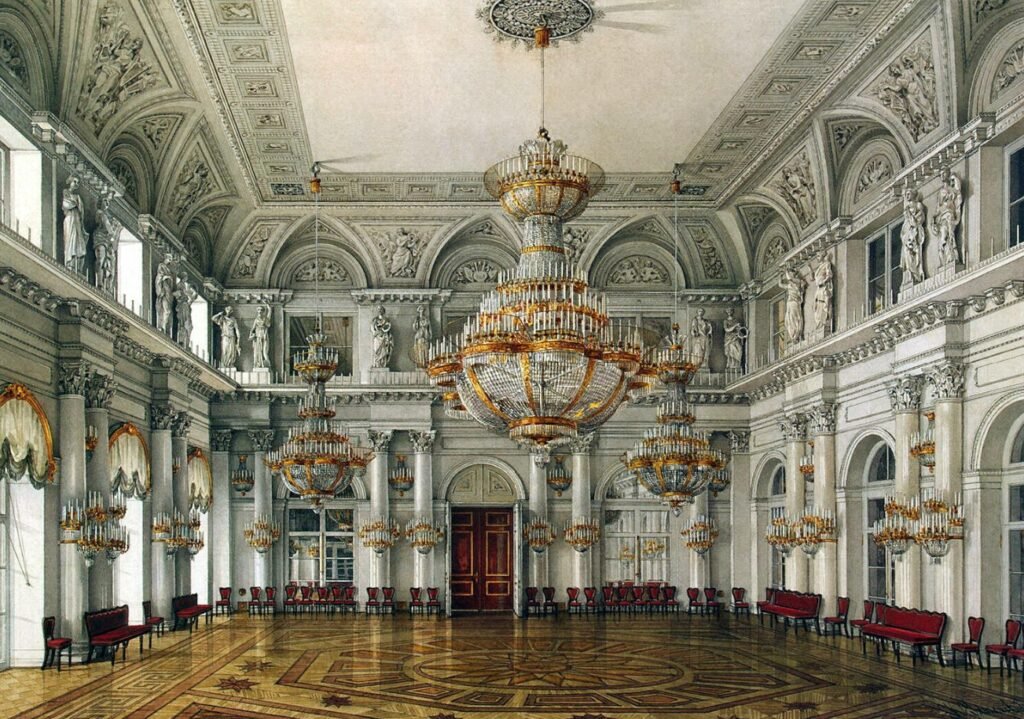

Tips:
Large bags are not allowed inside the Winter Palace. There is a bag check area next to the ticket office. Whether you’re exploring on your own or with a group, it’s highly recommended to listen to the guided tour. For those who want a deeper understanding of the Winter Palace, you can opt for an audio guide or hire a professional guide after purchasing your ticket, preferably someone whose style resonates with you.
The Winter Palace also offers online ticketing, and once your purchase is successful, you’ll receive a confirmation email. The ticket price is the same as buying at the door, but purchasing online allows you to skip the long lines. Simply present your booking confirmation and passport at the information desk to enter directly.
Palace Square
Palace Square is the central square of St. Petersburg, surrounded by the opulent architecture of the Tsarist era, with the Baroque-style Winter Palace at its northern end.
At the center of the square stands the Alexander Column, erected to commemorate the victory in the 1812 War against Napoleon. The column reaches a height of 47.5 meters, topped by a statue of an angel, which is said to be modeled after Tsar Alexander I. The column is made of red granite, measuring about 4 meters in diameter. Remarkably, despite weighing around 600 tons, it is not secured in any way at the base and has no visible supports.
On the southern side of the square is the former General Staff Building, designed by architect Rossi and completed in 1829. Among the various buildings that create a semicircle around the square, the Triumphal Arch spanning Bolshaya Morskaya Street connects the square to Nevsky Prospect. Above the arch, there’s a statue of the goddess of victory driving a chariot drawn by horses, also erected to commemorate the victory over Napoleon.
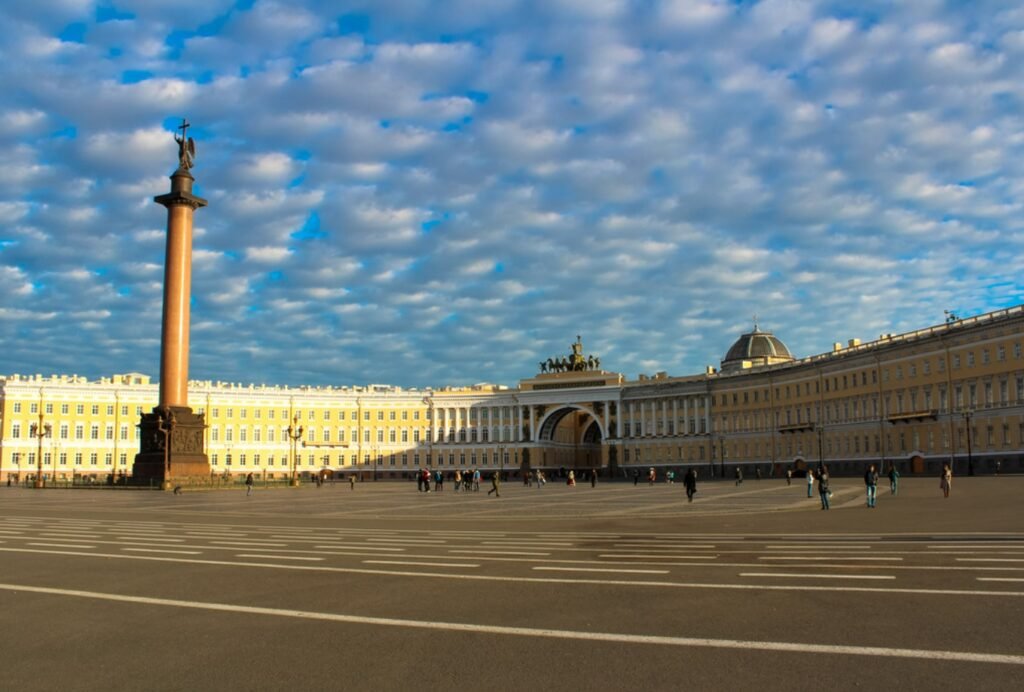
Admiralty
The Admiralty building was founded in 1704. Its most striking feature is a shining gilded spire that rises to a height of 72 meters, positioned atop the central stepped tower. This building once housed the naval headquarters and now serves as a naval school.
Designed by the renowned Russian architect Zakharov, the Admiralty is not open to the public, but its magnificent exterior always leaves visitors in awe.

Nevsky Prospekt
Nevsky Prospekt is one of the oldest roads in the city and is part of the larger Nevsky Avenue. It is generally divided into two sections, with the western side often referred to as Nevsky Prospekt and the eastern side leading to the Alexander Nevsky Monastery called Old Nevsky Prospekt.
As a bustling commercial street, it features many vibrant buildings. However, due to regulations that prevent any structure from exceeding the height of the Winter Palace, the competing designs have resulted in a beautifully uniform streetscape that is truly unique in the world.
The sightseeing center is located on the western part of the avenue, where many attractions are concentrated between the Old Admiralty and the Anichkov Bridge, spanning about 1.3 kilometers. Along this route, Nevsky Prospekt intersects with three rivers and canals, passing by notable buildings and squares.
Strolling Along Nevsky Prospekt
Starting from the Old Admiralty and heading east, you’ll cross the Moyka River, then continue forward to find Kazan Cathedral on your right. After crossing the Griboedov Canal, take the underpass at the next intersection to emerge on the sunny side, which leads to Arts Square; exiting on the shady side will bring you to St. Petersburg’s largest department store.
A few steps further from the store, you’ll arrive at Ostrovsky Square, which features a statue of Empress Catherine II. At the end of the road lies Anichkov Bridge, adorned with exquisite horse statues and a young bronze figure.
Additionally, Nevsky Prospekt runs predominantly east-west, with odd-numbered addresses on the shady side, often referred to as the “shady side,” while even-numbered addresses are known as the “sunny side.” Notably, at 14 Nevsky Prospekt, you can still find a wartime sign from World War II warning, “Attention! This side of the road is very dangerous in the event of an air raid.”
If you have some time, consider dedicating half a day to exploring Nevsky Prospekt on foot. It’s even better if you do some research in advance to locate the fascinating buildings with intriguing stories behind them.
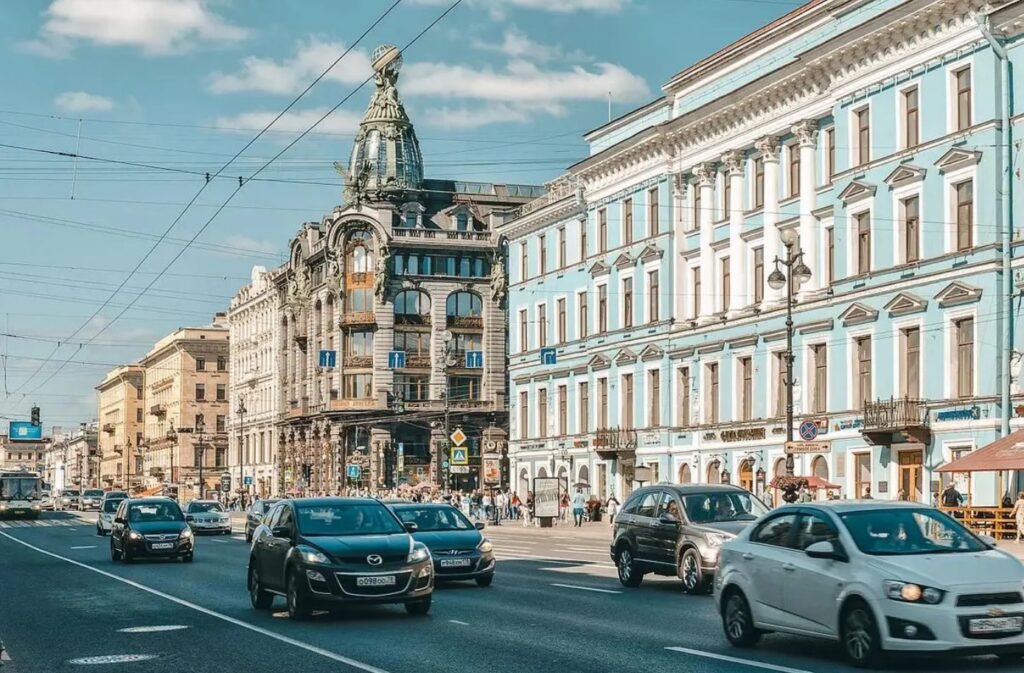
No. 21 – Former Mertens Fur Store
This classical-style building, constructed in 1912, features large arched glass windows on the first to fourth floors, creating the illusion that the middle floors are missing and the building appears to be hollow from the outside.
No. 28 – St. Petersburg’s Largest Bookstore
This building exemplifies the innovative architectural style of 1904. The exterior walls are adorned with various sculptures, and the globe atop the glass dome is particularly eye-catching. The first and second floors are clad in red granite, while the second to fifth floors are made of gray granite, topped with finely polished gray granite. In the bookstore, you can find beautiful, high-quality postcards.
No. 33A – Polutik
This narrow commercial street was built in 1806 but was demolished in the 1970s for the construction of the metro. Only the entrance area has been remodeled since. Across the street stands the European Hotel.
No. 35 – Department Store
Built in 1785, this large department store traces its origins to the early 18th century when it was established as a wooden commercial street in a hub for freight wagons.
No. 56 – Eliseevsky
Constructed in 1903, this mixed-use building reflects the early modern style, with theaters occupying the upper floors. The outer walls are decorated with statues that reflect themes of industry and commerce.
Church of the Saviour on Spilled Blood
The Church of the Saviour on Spilled Blood, also known as the Resurrection Church, was built between 1883 and 1907 and is one of the few examples of pure Russian architectural style in St. Petersburg. Its design is inspired by the iconic St. Basil’s Cathedral in Moscow. The church was erected on the site where Tsar Alexander II was assassinated on March 1, 1881.
One of the must-see highlights of the Church of the Saviour on Spilled Blood is its interior decoration, featuring over 6,000 square meters of stunning mosaic murals, predominantly depicting stories from the Old Testament.
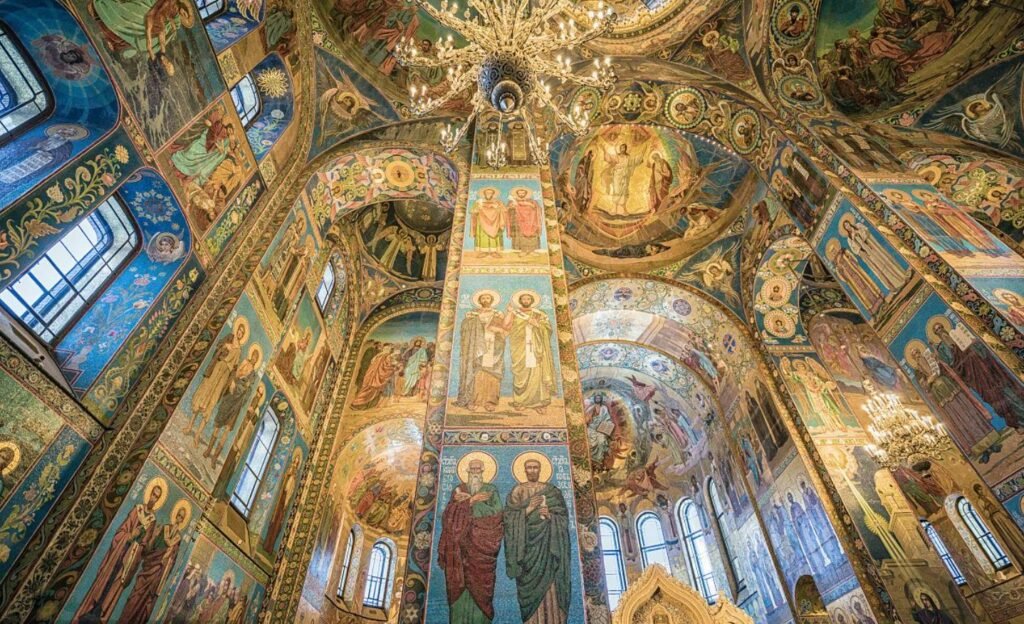

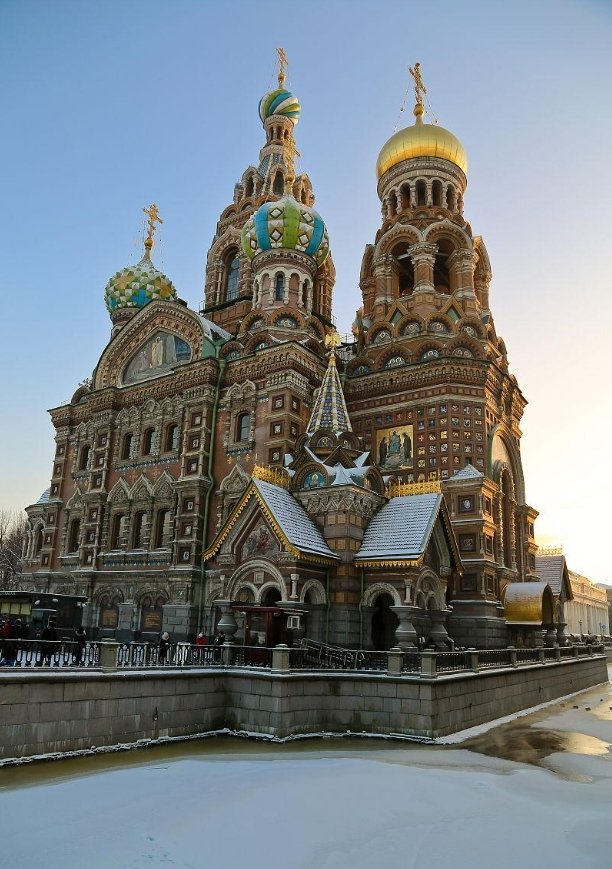
Russian Museum
The Russian Museum is housed in the original Mikhailovsky Palace, designed by the architect Rossi and built for Tsar Paul I’s son, Mikhail. The museum boasts an impressive collection of nearly 400,000 pieces, providing a comprehensive overview of Russian art history from the 12th to the 20th century.
Museum Visit Route
Start on the second floor of the palace, where you shouldn’t miss the White Hall (Exhibition Room 11), the most lavishly decorated room in the palace, used for receptions and performances.
Then head to Exhibition Room 14, which features one of Russia’s most famous oil paintings, Karl Bryullov’s “The Last Day of Pompeii,” along with Ivan Aivazovsky’s world-renowned painting “The Wave.”
After exploring the second floor, return to the first floor of Rossi’s building, then make your way to Benois Wing to conclude your visit. The rooms are numbered mostly in a counterclockwise direction and generally follow a chronological order.
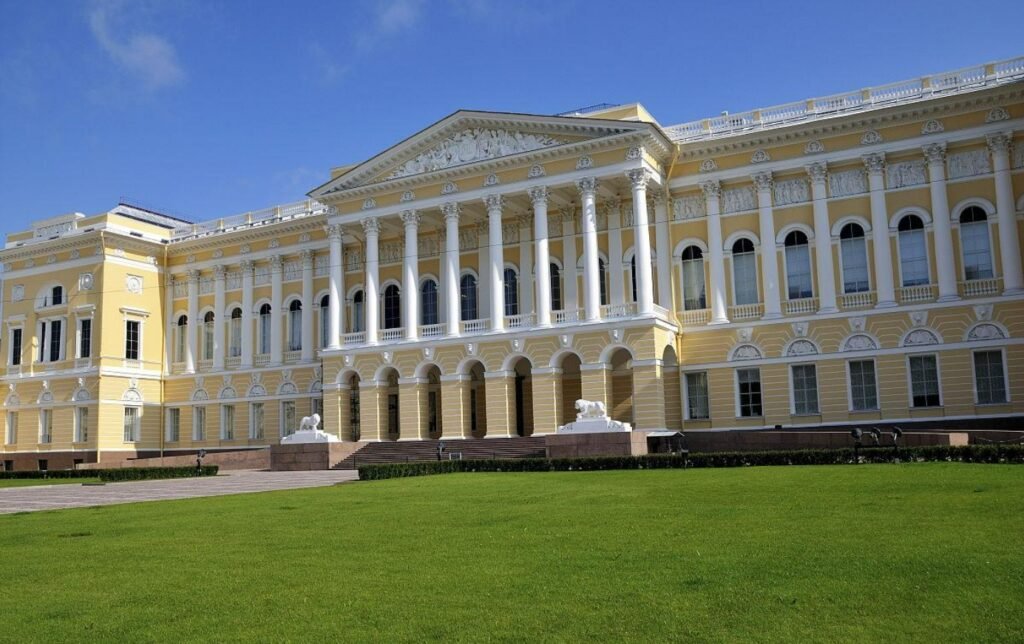
Kazan Cathedral
In the early 19th century, Kazan Cathedral was built on the orders of Tsar Paul I to house the revered Icon of Our Lady of Kazan. Construction began in 1801 and took a decade to complete. Since the city’s founding, this cathedral has preserved a miraculous masterpiece—the Icon of Our Lady of Kazan, which is said to have protected Moscow from invasions by the Lithuanian-Polish alliance. The tomb of General Kutuzov is also located within the cathedral.
The project was designed by the serf-born architect Voronikhin, who, in response to the tsar’s desire for a structure reminiscent of St. Peter’s Basilica in Vatican City, created a semi-circular colonnade featuring 94 columns. As a result, the Kazan Cathedral doesn’t have the typical appearance of an Orthodox church at first glance.
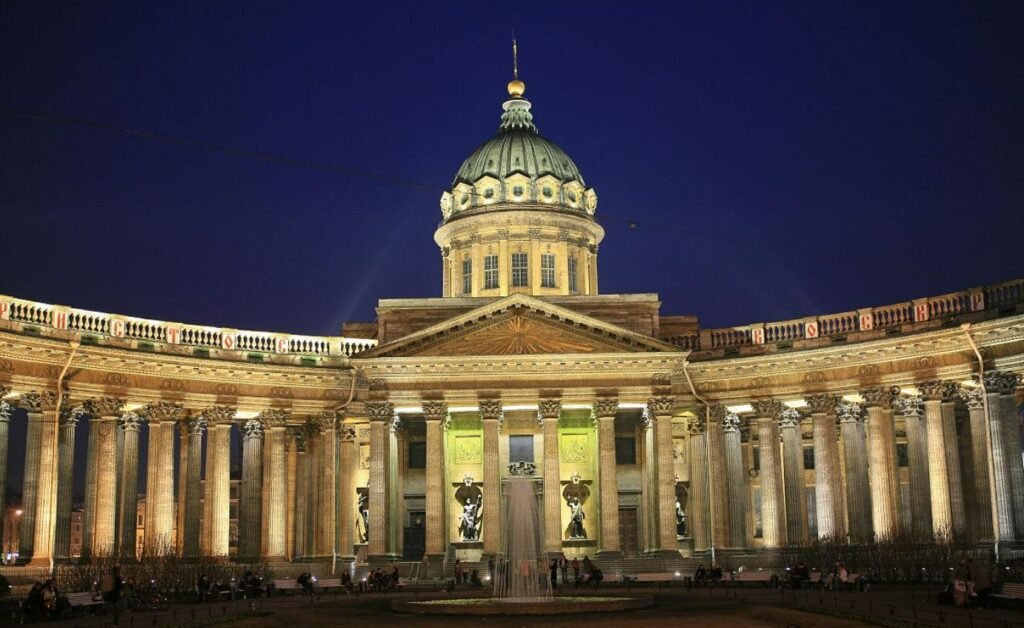
Saint Petersburg State Museum of Theatre and Music
The Saint Petersburg State Museum of Theatre and Music is located behind the Aleksandrinsky Theatre. For those fascinated by Russian drama and music, visiting this museum can feel like discovering a hidden treasure.
In fact, it serves as an underground vault of Russian theatre history, housing an extensive collection of items related to the performing arts, including costumes, posters, and props. If you’re visiting with children, they can enjoy hands-on experiences in the kids’ section, where they can play with models of the Mariinsky Theatre stage and explore sound effects props, such as old devices that simulate wind, rain, and train whistles.
Alexander Nevsky Lavra
The Alexander Nevsky Lavra was established in 1710 to honor the Russian saint Alexander Nevsky (1219-1263) and remains in use today.
At the center of the monastery is the yellow-painted Trinity Church. Upon entering the Lavra, you’ll find the oldest building on the left, the Annunciation Bell Tower.
Visitors with a historical or literary interest often come to the monastery to see the cemeteries flanking the main gate, particularly Tikhvin Cemetery (Tikhvin Skete), where several notable figures are laid to rest. Among them are the great composers Tchaikovsky, Borodin, Mussorgsky, and Glinka.
Decemberists Square
Decemberists Square is best known for St. Isaac’s Cathedral and the bronze statue of the Bronze Horseman that stands in front of it.
This square has historical significance, as it was here that Russian revolutionaries once challenged and fought against the rulers. On December 10, 1825, the Decemberists organized and stormed the Senate from this very spot, demanding the abolition of the tsarist regime and the liberation of serfs. In honor of this uprising, the square was renamed “Decemberists Square” in 1925 to commemorate the 100th anniversary of the Decemberist revolt.
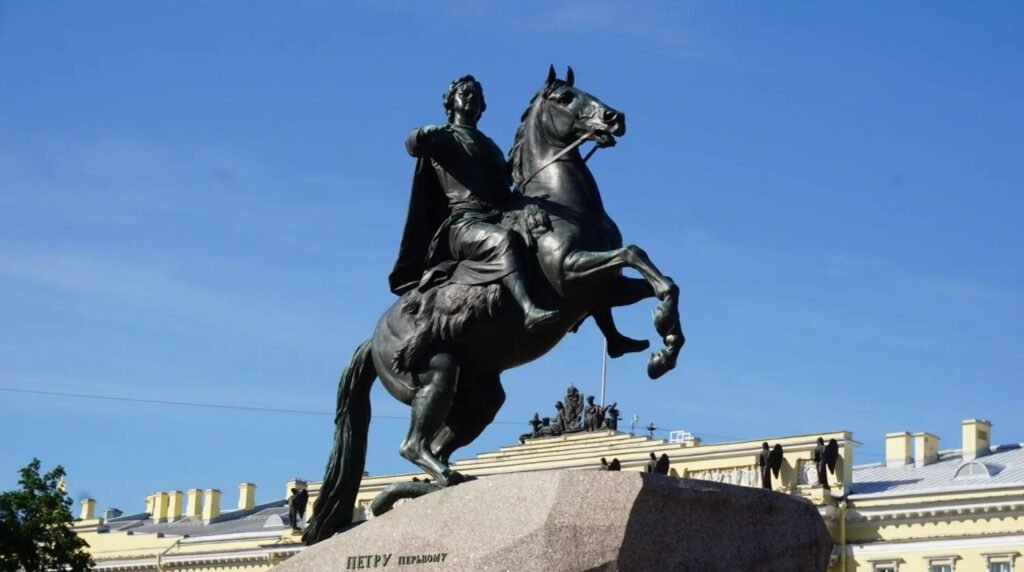
Zoological Museum
Prepare to be amazed! This museum is housed in what was once a customs warehouse and is one of the few large-scale zoological museums in the world. It features over 30,000 specimens and taxidermied animals, including mammals, birds, fish, and insects.
Among its highlights are the skeletal remains of the extinct Steller’s sea cow and a taxidermied Tasmanian tiger. However, the true gem of the museum is the world-famous 4,500-year-old woolly mammoth specimen, discovered in 1900 along the banks of the Belyozovka River in Yakutia, where its fur remains remarkably well-preserved. The museum also displays a mummified woolly mammoth that was born just about 3-4 months before it passed away.
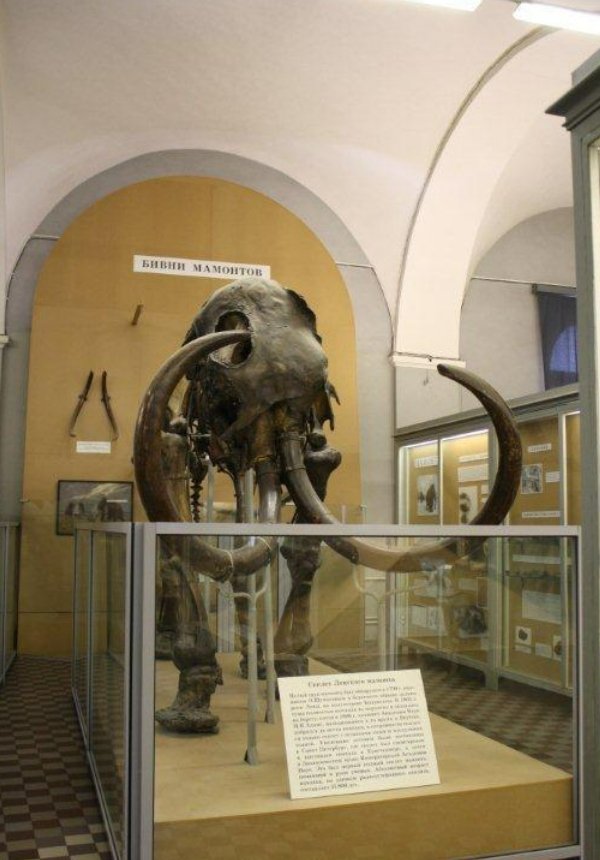

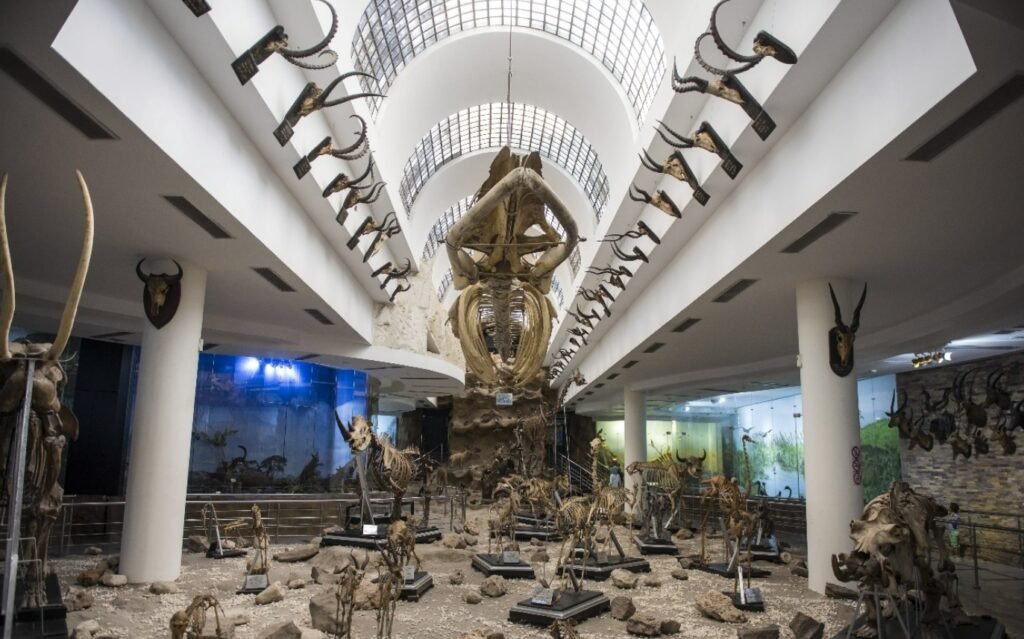
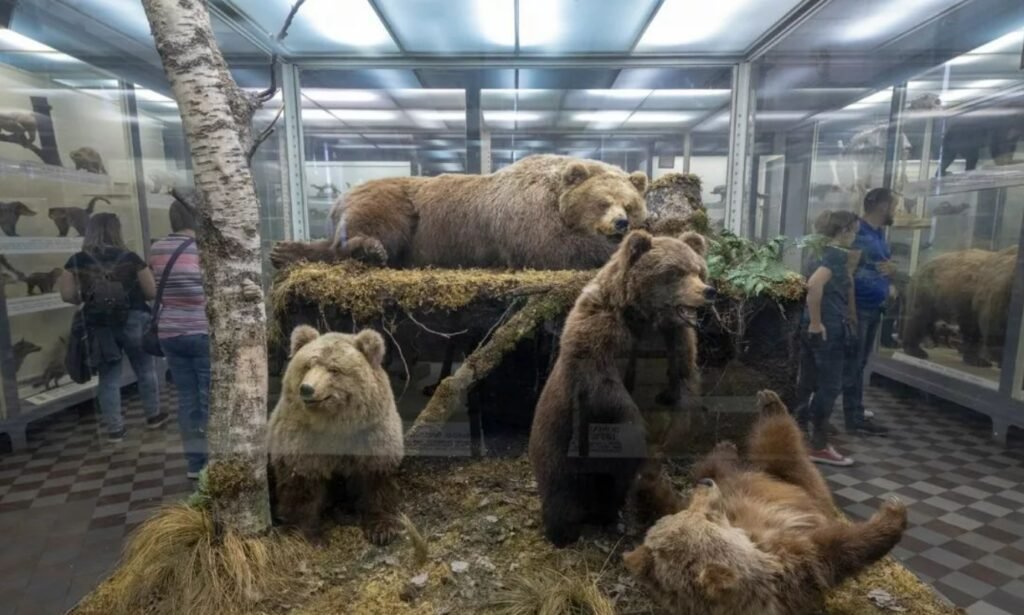
The Summer Palace of Peter (Peterhof)
The Peterhof Palace, also known as the Summer Palace, is located about 30 kilometers from St. Petersburg, nestled within a forest along the southern shore of the Gulf of Finland. Spanning nearly a thousand hectares, it served as a suburban residence for Russian emperors. Construction began in 1714, and the palace is renowned for its lavish architecture, often referred to as the “Russian Versailles.”
The creation of this palace involved the collaboration of the world’s finest architects and craftsmen from France and Italy. Peter the Great actively participated in the planning and provided specific instructions for the project. Today, several of the original design plans drafted by him have been preserved.
The grand opening of the palace and its gardens took place in 1723, just two years before Peter the Great’s death. Key buildings within the complex include the Grand Palace, the Summer Garden, the Marly Palace, the Hermitage Pavilion, and the Alexander Garden.
During World War II, Peterhof suffered significant damage from the German army, but it has since been restored and was designated a UNESCO World Heritage Site.
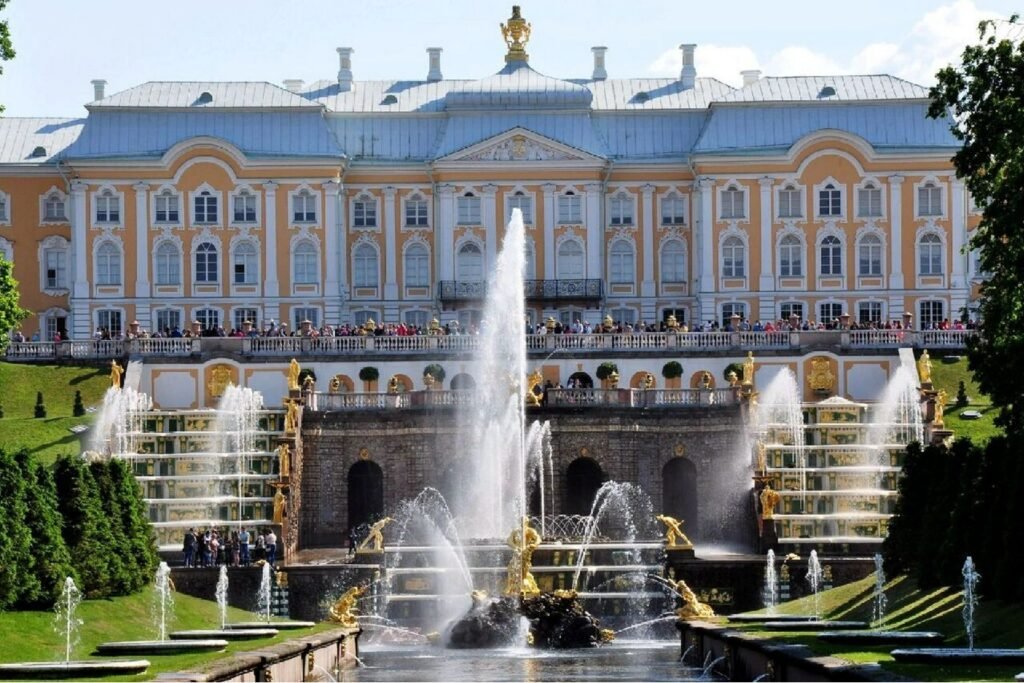
The Catherine Palace
The Catherine Palace was originally a gift from Peter the Great to his wife, Catherine, and later became the property of their daughter, Empress Elizabeth Petrovna.
The palace is surrounded by a 300-meter-long wall and is designed in the Baroque style. Ascending the central staircase to the second floor, visitors are greeted by two angel statues. Flanking the windows are the “Awakening Angel” on the east side and the “Sleeping Angel” on the west. Exiting the historical exhibition room connected to these statues leads to a grand hall.
From there, visitors can explore the dining room and portrait gallery, eventually arriving at the most remarkable feature of the palace: the Amber Room . The walls of this room are adorned with amber, creating a breathtaking spectacle unlike anything else.
Other luxurious rooms include the Picture Gallery, decorated with exquisite paintings; the Green Dining Room, featuring beautiful Roman-style reliefs and wall paintings; and the Blue Drawing Room, with its walls covered in printed silk. Currently, a total of 29 rooms in the palace have been restored.
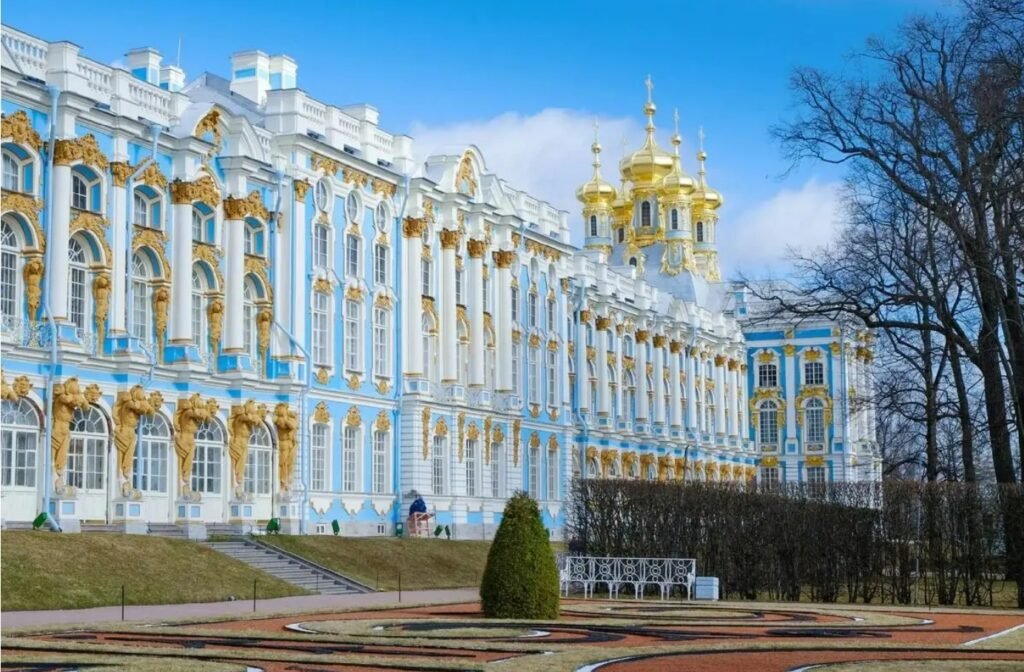
The Legendary Amber Room
The Amber Room originated in the early 18th century with a few amber wall panels created by the Prussians. The Prussian King Frederick I was the first to construct a room filled with amber panels, which were later gifted to Peter the Great during his visit to Prussia by his son, Frederick William I.
Empress Elizabeth was the first to begin processing the amber, and in 1755, the Amber Room was transferred to the Catherine Palace. Catherine, a lover of the arts, took a keen interest in the project. Under her supervision, the layout of the Amber Room was redesigned to include techniques such as mirrored panels, gemstone inlays, and gold leaf applications. For missing sections, false wall panels were initially installed, and skilled artisans later replaced them with newly crafted amber panels.
It wasn’t until 1770 that the Amber Room’s final appearance was revealed. For nearly 150 years afterward, it was used to receive nobles and guests, undergoing continuous restoration and maintenance.
During World War II, the Catherine Palace was occupied by German troops. When they retreated in 1944, the entire Amber Room was taken, and it has since remained missing. Starting in 1980, Russia dedicated efforts to restore the lost Amber Room. Despite a severe shortage of materials, the hard work of craftsmen culminated in its completion in 2003, coinciding with the 300th anniversary of Saint Petersburg.
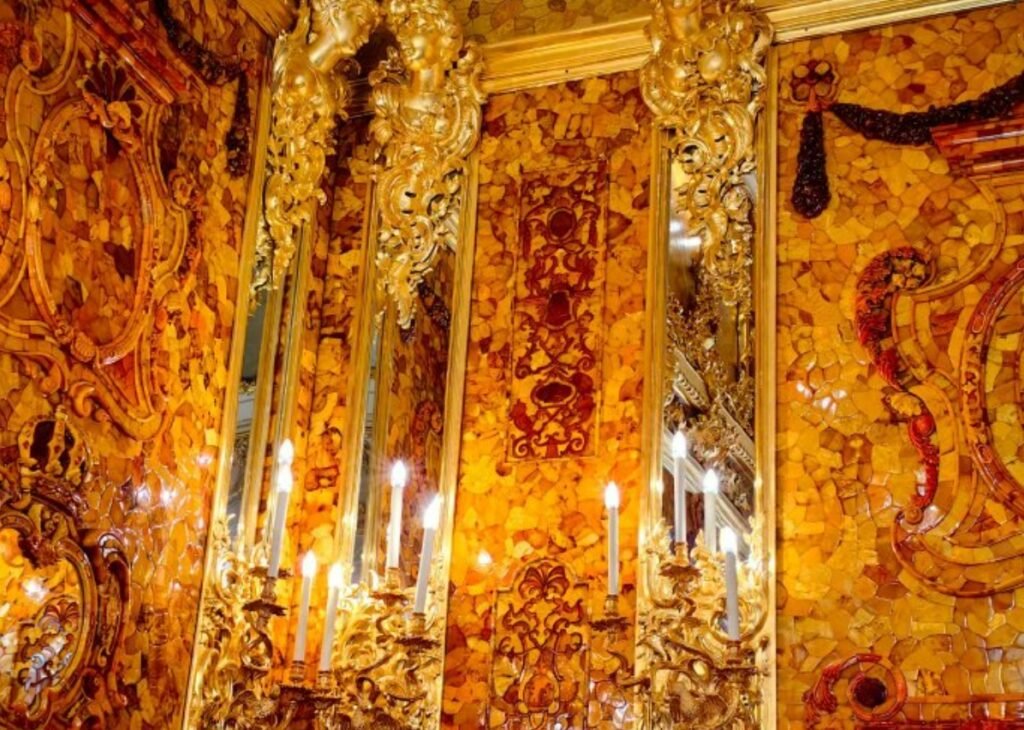
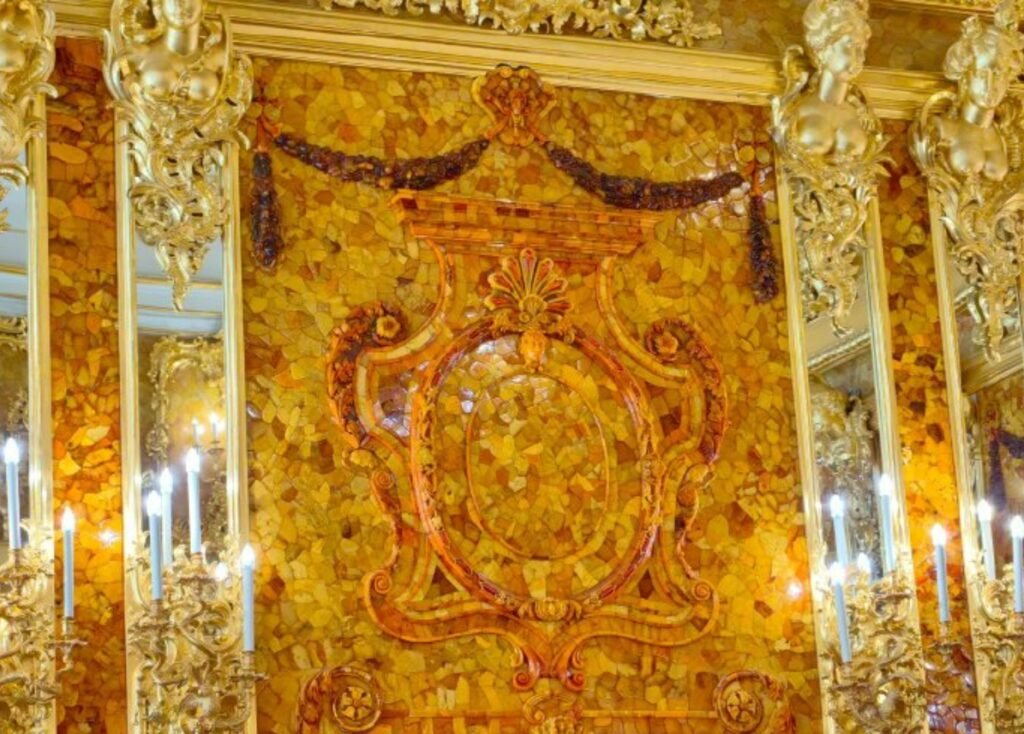
Accommodation Guide for Saint Petersburg
Saint Petersburg offers a wide range of hotel options, including both local hotels and a number of Chinese hostels. Most star-rated hotels are concentrated in the city center, with high-end options starting at around $400 during peak season. Four-star hotels typically range around $200, while family-run guesthouses and youth hostels are much cheaper, usually between $80 and $100, with bed rates ranging from $15 to $50 per bed.
In Saint Petersburg, hotels are primarily located along Nevsky Prospekt and around major attractions. The city is structured in an irregular radial pattern centered around the Winter Palace. Since the attractions in Saint Petersburg are relatively concentrated, staying in a well-located hostel can save you a lot of energy and money.
Culinary Guide to Russian Cuisine
Russian cuisine reflects the character of its people: robust, hearty, and often rich in flavor and calories. The diversity of Russian food is especially evident in its cold dishes, such as pickled cucumbers, salads, sausages, cheeses, and jellied fish. It’s not uncommon for a typical family meal to feature nearly ten varieties of cold appetizers. Dinner often skips soup and goes directly to the main course, usually grilled chicken, duck, fish, or meat.
Desserts follow the main course, including cakes, sweet pies, jams, chocolates, fruits, and ice cream, often accompanied by a pot of strong tea for leisurely enjoyment and conversation.
While traditional Russian meals are relatively simple, the cuisine is highly adaptable and open to influences. This trait, combined with the Russian penchant for embracing new ideas, has allowed various international dishes to become part of Russian cuisine. For instance, Chinese dumplings, German sausages, British steaks, Tatar lamb, Ukrainian borscht, and Olivier salad have all been integrated and modified into beloved Russian dishes.
Key features of Russian cuisine include:
- Caviar: Black and red caviar are delicacies. The common pairing is black sturgeon caviar with crisp white wine and hearty bread, a typical local combination. Surprisingly, caviar is relatively affordable and can be found in most supermarkets.
- Sausages and Hams: A wide variety of sausages and cured meats are staples in Russian households.
- Pickled Foods: Items like salted fish, pickled mushrooms, and pickled vegetables are common accompaniments to meals.
- Bread: The primary staple is bread made from rye and wheat flour. Rye bread, in particular, is beloved by Russians and often served to guests. It has a dense texture and a slightly sour taste.
Russians enjoy cold drinks and desserts year-round; it’s not unusual to see people eating ice cream even in temperatures below -20°C. Vodka, a point of national pride, is a popular alcoholic beverage, and many Russians are known for their impressive drinking capacity.
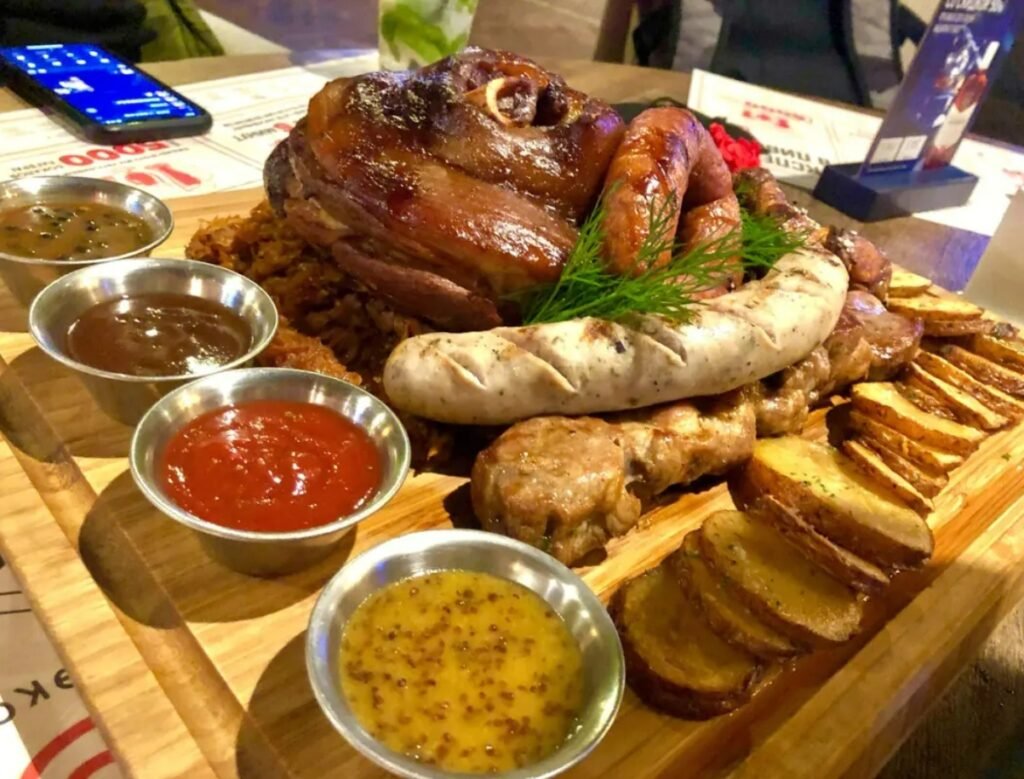

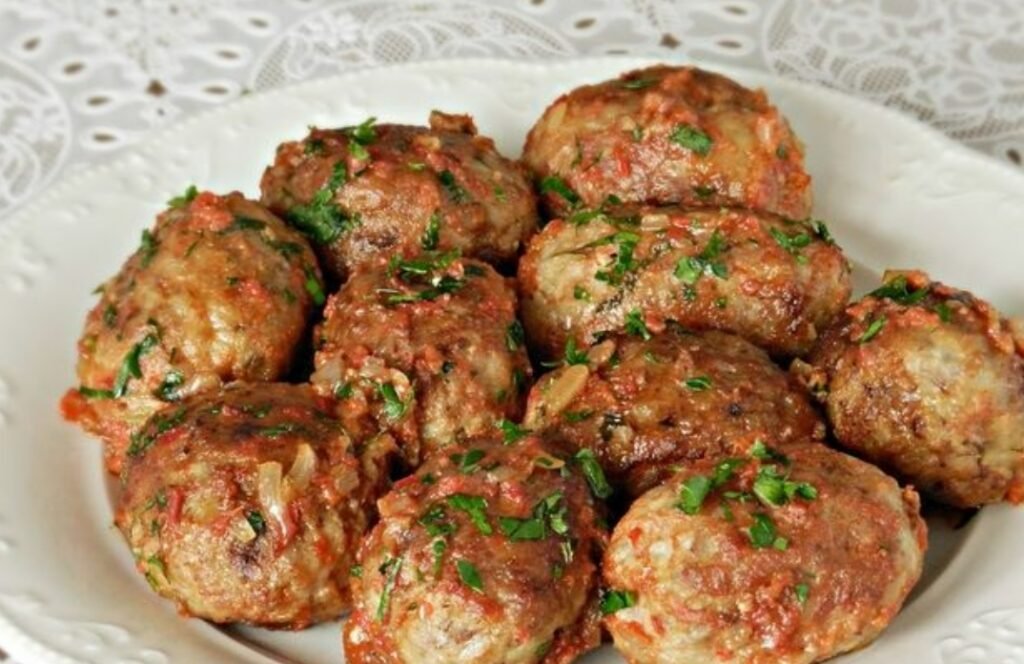
Saint Petersburg Itinerary Guide
Saint Petersburg’s attractions are quite concentrated, making it feasible to explore on foot, especially along Nevsky Prospect. If you’re up for it, you can spend one or two days visiting the classic sites in the historical center before venturing out to farther locations like Tsarskoye Selo (Catherine Palace) and Peterhof (Summer Palace). Here’s a detailed 3-day itinerary for your visit:
Day 1: Exploring the Historical Center
- Start at Kazan Cathedral: Begin your walk along Nevsky Prospect at the magnificent Kazan Cathedral. There are many street vendors nearby where you can grab a hot dog or snack as you stroll.
- Walk to the Church of the Savior on Spilled Blood: Head toward the canals and take a left into the alley that leads to the Church of the Savior on Spilled Blood. The best photo angle of the church is from the bridge nearby.
- Continue to Peter and Paul Fortress: After enjoying the church, continue walking along the canal. Cross over Troitsky Bridge (TponцKИЙMOCT) to get a good view of the Peter and Paul Fortress. Inside the fortress, you can visit the Wax Museum and the Peterburg History Museum. For an extra fee, you can access the observation deck for stunning views.
- Visit the Cruiser Aurora: After crossing the bridge, turn right to find the Cruiser Aurora. There are many souvenir vendors near the ship.
- Open Area of Manezh Square: Return the way you came and head toward Manezh Square (MapcoBonone), passing the Church of the Savior on Spilled Blood again. Walk along the small river past the church to reach the Russian Museum.
- Finish at Arts Square: After exploring the museum, walk through Arts Square and then make your way back to Nevsky Prospect.
Day 2: Winter Palace and Surroundings
- Visit Palace Square: Take the metro to Palace Square (Dvortsovaya Ploshchad). Marvel at the Alexander Column (AлeкcaндpoвcкaЯ Koлoннa) in the center of the square.
- Explore the Hermitage Museum: Dedicate at least half a day to exploring the Hermitage Museum, which is located in the Winter Palace.
- Walk Along the Neva River: After visiting the museum, stroll along the Neva River to the Naval Headquarters building.
- See the Bronze Horseman: Continue your walk to the expansive grassy area where the Bronze Horseman statue stands, with the golden onion domes of St. Isaac’s Cathedral in the background.
Day 3: Catherine Palace in Tsarskoye Selo
- Head to Tsarskoye Selo: Depart around 8 AM. Take the metro to Moskovskaya (blue line), then catch minibus 342 or 545 to reach Tsarskoye Selo (approximately 1.5 hours travel time).
- Catherine Palace Visit: The Catherine Palace is open for visitors during specific times (12:00-14:00 and 16:00-17:00). If you have an international student ID, you may get a discount or free entry.
- Explore the Parks: Before your palace visit, enjoy the park surrounding the palace. Unlike the Summer Palace, this area feels like a summer retreat, with beautiful skies and scenic architecture. Take your time to stroll and soak in the atmosphere.
- Visit the Amber Room: Return to the palace around noon to join the queue for the Catherine Palace. Only the middle floor is open to visitors, and each room entry has a ticket fee that may be higher than the Summer Palace. Don’t miss the stunning Amber Room.
- Check Out the Chinese Park: After exploring the gardens, venture to the back to find a Chinese-style park. There are small churches nearby to explore before you wrap up your day.
- Return to the City: Catch a train back at around 5 PM.

